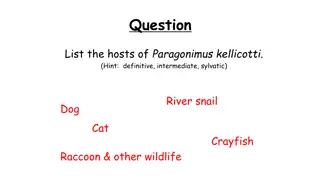Comprehensive Overview of Blood Flukes: Schistosoma Species
Explore the world of blood flukes, focusing on the Schistosoma species. Learn about their general characteristics, life cycle stages, comparison between different species, and their impact on human health. Discover key aspects such as morphology, hosts, egg characteristics, and how diagnosis of infections is conducted through microscopic examination. Unveil the intricacies of these parasitic worms and their role in causing the disease bilharziasis.
Download Presentation

Please find below an Image/Link to download the presentation.
The content on the website is provided AS IS for your information and personal use only. It may not be sold, licensed, or shared on other websites without obtaining consent from the author. Download presentation by click this link. If you encounter any issues during the download, it is possible that the publisher has removed the file from their server.
E N D
Presentation Transcript
Lab 7 HELMINTHOLOGY HELMINTHOLOGY PART PART 2 2
*Blood flukes: - Ex: - Schistosoma Spp. Schistosama Spp. adult suckers
General characteristics :- Cylindrical, diecious worms, have oral and ventral suckers. The male is shorter than the female and has gynecophoric canal in which the female is hold. The cercaria has forked-tail (infective stage). They have not redia stage. The eggs have spine.
Schistosama Spp. cercaria (forked tail cercria) Schistosama Spp. copulation (male and female )
There are three species of schistosomes :- Ex.1:-Schistosoma haematobium Ex.2:-Schistosoma mansoni Ex.3:-Schistosoma japonicum
Table(1):-Comparison between the three types of Schistosoma Spp.(b) S. haematobium 1. Final host Man. S. mansoni Man. S. japonicum Man. 2.Intermediat e host 3-Egg Snail Bulinus Spp. Snail Biomphalaria Spp. Has big lateral spine pass in feces. Snail Oncomelania Spp. Has small lateral spine pass in feces. Has terminal spine pass in urine. Schistosoma haematobium ovum Schistosoma mansoni ovum Schistosoma japonicum ovum
4-Adult male: Tegument Slightly tuberculated. Coarsely tuberculated. Smooth. Schistosoma mansoni male tegume Testes 4 5. 8 9. 6 - 8 . Intestine Reunite in the center. Reunite in the anterior half. Reunite in the posterior half.
5-Adult female: Ovary In the posterior half. In the anterior half. Ovary central. Uterus Has 20 30 ova. Has 1 4 ova. Has 50 100 ova. 6- location Pelvic venous plexuses Mesenteric venous plexuses Mesenteric venous plexuses
7- Disease Bilharziasis Bilharziasis Bilharziasis 8- Diagnosis Microscopic examination of urine specimens contain ova. Microscopic examination of stool specimens contain ova Microscopic examination of stool specimens contain ova.























